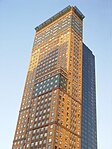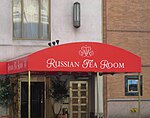57th Street–Seventh Avenue station
57th Street (Manhattan)Accessible New York City Subway stationsBMT Broadway Line stationsMidtown ManhattanNew York City Subway stations in Manhattan ... and 4 more
New York City Subway stations located undergroundRailway stations in the United States opened in 1919Seventh Avenue (Manhattan)Use mdy dates from January 2017

The 57th Street–Seventh Avenue station (signed as 57th Street) is an express station on the BMT Broadway Line of the New York City Subway. Located in Midtown Manhattan at the intersection of 57th Street and Seventh Avenue, it is served by the N and Q trains at all times, the R train at all times except late nights, and the W train on weekdays. It is directly adjacent to Carnegie Hall.
Excerpt from the Wikipedia article 57th Street–Seventh Avenue station (License: CC BY-SA 3.0, Authors, Images).57th Street–Seventh Avenue station
7th Avenue, New York Manhattan
Geographical coordinates (GPS) Address Phone number Website Nearby Places Show on map
Geographical coordinates (GPS)
| Latitude | Longitude |
|---|---|
| N 40.765461 ° | E -73.980088 ° |
Address
Carnegie Hall
7th Avenue
10019 New York, Manhattan
New York, United States
Open on Google Maps










